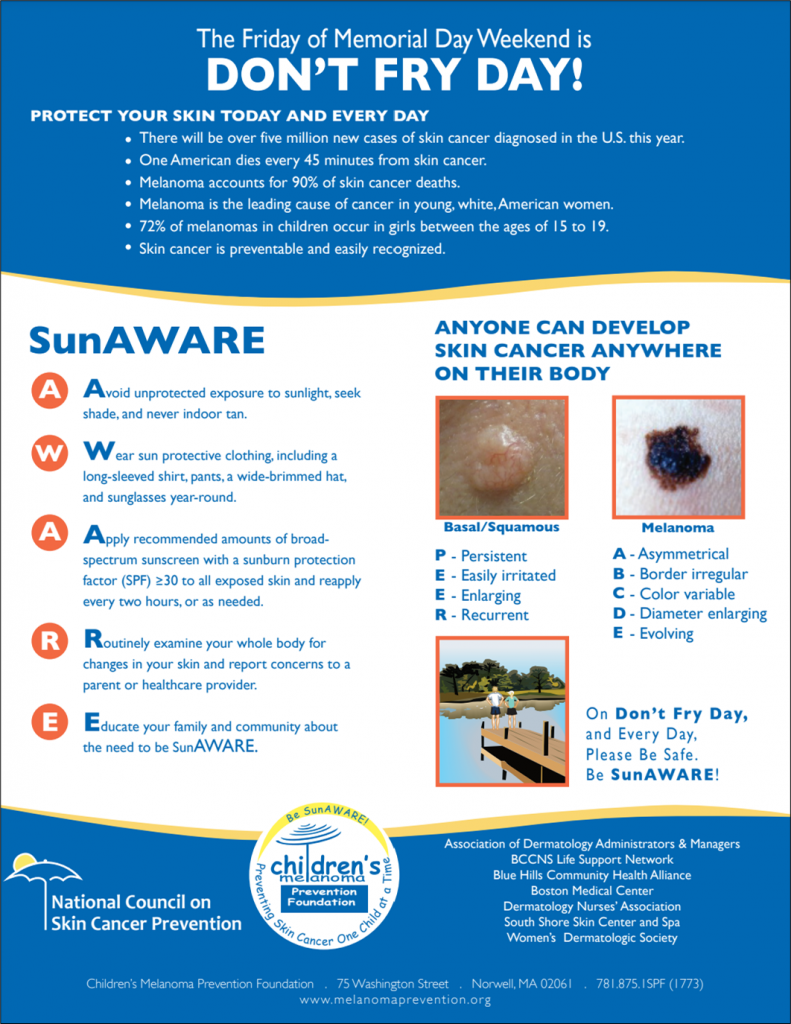Time to Celebrate!
As we move towards Memorial Day weekend, many of us may have plans to spend it outdoors grilling, enjoying the beach or lake, picnicking with friends, and remembering those special people in our lives who have passed while serving our country. As you celebrate and honor the service women and men and enjoy the outdoors, it is important to remember to protect your skin. The Friday leading into Memorial Day weekend is “Don’t Fry Day!” It’s a time to be “Sun AWARE: Avoid-Wear-Apply-Routinely-Educate” and take action to reduce your risk of skin damage and cancers.
Know the Facts
UV (Ultraviolet) Rays: UV rays are the sun’s rays that damage your skin. It’s also what has the potential to cause skin cancers. The two basic types of UV rays are UVA and UVB rays.
UVA Rays: 95% of all UV rays from the sun are UVA rays (MDAnderson.org). UVA rays play a role in premature skin aging.
UVB Rays: Makes up 5% of UV rays from the sun (MDAnderson.org). While the percentage may seem small, UVB can cause “DNA mutations leading to melanoma and other skin cancers as well as cause cataracts.”
UV Index: Predicted by the National Weather Service, the UV Index is an indicator of UV light strength on a scale from 1-11+. A lower number indicates less risk of exposure to UV rays and a higher number indicates a higher risk. Find out what the UV Index is for your area by visiting the U.S. Environmental Protection Agency site. Once on the site, enter your zip code. From there, you will have the option to view a daily and hourly UV Index. You will see a chart that explains the exposure category based on the Index number as well Sun Protection Messages.
Who is at Risk?
Everyone is a risk of damage from the sun; however, there are some individuals that are more susceptible than others. According to the American Cancer Society, “naturally darker skin is less likely to get sunburned, while people with lighter skin are more likely to burn, increasing risk of skin cancer, including melanoma” (American Cancer Society, 2019). Other factors that will impact your risk of damage from UV light includes (American Cancer Society, 2019):
- Having skin cancer previously
- Having a family history of skin cancer
- Having fair skin with blue or green eyes
- Working indoors during the week and getting intense sun exposure on the weekends
- Taking medication that suppress your immune system.
For additional risk factors, check out the article by the American Cancer Society, Are Some People More Likely to Get Skin Damage from the Sun?
Tips to Protect Your Skin
- If you plan to be outside, avoid 10am – 4pm when possible. This is when the UV rays are strongest.
- Wear a cover-up or other protective clothing– this includes your eyes!
- Choose sunglasses with ≥99% UV light blocking power.
- Wear a hat.
- Avoid tanning beds and tanning lamps.
- Do not burn.
- Choose a shady area when possible.
- Apply sunscreen according to the instructions.
Sunscreen Label Lingo
Expiration Date: Be sure your sunscreen has not expired. You want to protect your skin as much as possible by using a product that has not expired.
Broad-Spectrum: Protects against UVA and UVB rays.
Sun Protection Factor (SPF): Protection against UVB rays. Choose a SPF of ≥30. Below a SPF 15 does not protect against skin damage including aging or cancer.
Water Resistant: Some sunscreens can still protect you when swimming or sweating; however, it is critical to check the label to see how often you need to reapply.
Not sure about the ingredients found in sunscreens? Check out the article, How Safe is Your Sunscreen? by Stacy Simon with the American Cancer Society.
Ready for a Day in the Sun?
Before heading outdoors, whether it is a bright and sunny or an overcast day, use this Sun Safety Packing List to help you reduce your risk of damage from the sun.
Adapted from an original post, Wellness with Wendy e-news (March 19, 2021).
Author: Wendy W. Lynch
 1
1

